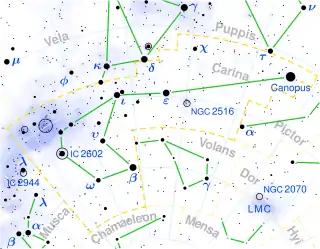EV Carinae
EV Carinae is a red supergiant and pulsating variable star of spectral type M4Ia in the constellation Carina. It is a semiregular variable star with its apparent magnitude varying between 7.4 and 9.0 in the visible band, making it only seen by binoculars or a telescope. Various periods have been identified, but the dominant one is around 347 days.[6] It is an MK spectral standard star for the class M4.5Ia.[4]
 | |
| Observation data Epoch J2000.0 Equinox J2000.0 | |
|---|---|
| Constellation | Carina |
| Right ascension | 10h 20m 21.608s[1] |
| Declination | −60° 27′ 15.55″[1] |
| Apparent magnitude (V) | 7.4 - 9.0[2] |
| Characteristics | |
| Evolutionary stage | Red supergiant |
| Spectral type | M4.5Ia[3][4] |
| U−B color index | +2.34[5] |
| B−V color index | +2.20[5] |
| Variable type | SRc[6][2][7] |
| Astrometry | |
| Radial velocity (Rv) | 2.0[8] km/s |
| Proper motion (μ) | RA: −6.1[9] mas/yr Dec.: 2.4[9] mas/yr |
| Parallax (π) | 0.7759 ± 0.1098[10] mas |
| Distance | 2,960+220 −200[11] pc |
| Absolute magnitude (MV) | −5.24[5] |
| Details | |
| Mass | 5.36[12] M☉ |
| Radius | 1,168[13] R☉ |
| Luminosity (bolometric) | 288,000+75,000 −79,000[11] L☉ |
| Temperature | 3,535±170[14] K |
| Metallicity [Fe/H] | +0.25[12] dex |
| Other designations | |
| Database references | |
| SIMBAD | data |
EV Car is one of the largest known stars although its properties depend on its distance. In the late of the 20th century, EV Carinae, based on an assumed distance of 4.2 kpc, was found to be an extremely luminous and large supergiant star with an unusual luminosity between 550,000 and 675,000 times that of the Sun (L☉), which would imply radii of 2,880 to 3,190 times the Sun's radius (R☉) at a temperature of 2,930 K, making it larger than the orbit of Saturn.[15]
More recently, new calculations of the distance derived closer distances below 3 kpc which would put EV Car part of the Carina OB2 association along the Carina Nebula and give the star lower luminosities below 300,000 L☉, higher temperatures, and correspondingly lower radius values,[13][5][11] while calculation of the bolometric luminosity based on a Gaia Data Release 2 parallax of 0.7759±0.1098 mas gives a luminosity below 50,000 L☉ with a corresponding radius of 574 R☉, but that value is considered unreliable due to a very high level of astrometric noise.[14]
References
- Cutri, R. M.; Skrutskie, M. F.; Van Dyk, S.; Beichman, C. A.; Carpenter, J. M.; Chester, T.; Cambresy, L.; Evans, T.; Fowler, J.; Gizis, J.; Howard, E.; Huchra, J.; Jarrett, T.; Kopan, E. L.; Kirkpatrick, J. D.; Light, R. M.; Marsh, K. A.; McCallon, H.; Schneider, S.; Stiening, R.; Sykes, M.; Weinberg, M.; Wheaton, W. A.; Wheelock, S.; Zacarias, N. (2003). "VizieR Online Data Catalog: 2MASS All-Sky Catalog of Point Sources (Cutri+ 2003)". VizieR On-line Data Catalog: II/246. Originally Published in: 2003yCat.2246....0C. 2246. Bibcode:2003yCat.2246....0C.
- Kiss, L. L.; Szabó, Gy. M.; Bedding, T. R. (2006). "Variability in red supergiant stars: Pulsations, long secondary periods and convection noise". Monthly Notices of the Royal Astronomical Society. 372 (4): 1721–1734. arXiv:astro-ph/0608438. Bibcode:2006MNRAS.372.1721K. doi:10.1111/j.1365-2966.2006.10973.x. S2CID 5203133.
- "GCVS Query=EV Car". Sternberg Astronomical Institute. General Catalogue of Variable Stars @ Sternberg Astronomical Institute, Moscow, Russia. Retrieved 2020-08-11.
- Keenan, Philip C.; McNeil, Raymond C. (1989). "The Perkins catalog of revised MK types for the cooler stars". Astrophysical Journal Supplement Series. 71: 245. Bibcode:1989ApJS...71..245K. doi:10.1086/191373.
- Mauron, N.; Josselin, E. (2011). "The mass-loss rates of red supergiants and the de Jager prescription". Astronomy and Astrophysics. 526: A156. arXiv:1010.5369. Bibcode:2011A&A...526A.156M. doi:10.1051/0004-6361/201013993. S2CID 119276502.
- Samus, N. N.; Durlevich, O. V.; et al. (2009). "VizieR Online Data Catalog: General Catalogue of Variable Stars (Samus+ 2007-2013)". VizieR On-line Data Catalog: B/GCVS. Originally Published in: 2009yCat....102025S. 1. Bibcode:2009yCat....102025S.
- Percy, John R.; Sato, Hiromitsu (2009). "Long Secondary Periods in Pulsating Red Supergiant Stars". Journal of the Royal Astronomical Society of Canada. 103 (1): 11. Bibcode:2009JRASC.103...11P.
- Feast, M. W.; Woolley, R.; Yilmaz, N. (1972). "The kinematics of semi-regular red variables in the solar neighbourhood". Monthly Notices of the Royal Astronomical Society. 158: 23–46. Bibcode:1972MNRAS.158...23F. doi:10.1093/mnras/158.1.23.
- Høg, E.; Fabricius, C.; Makarov, V. V.; Urban, S.; Corbin, T.; Wycoff, G.; Bastian, U.; Schwekendiek, P.; Wicenec, A. (2000). "The Tycho-2 catalogue of the 2.5 million brightest stars". Astronomy and Astrophysics. 355: L27. Bibcode:2000A&A...355L..27H. doi:10.1888/0333750888/2862.
- Brown, A. G. A.; et al. (Gaia collaboration) (August 2018). "Gaia Data Release 2: Summary of the contents and survey properties". Astronomy & Astrophysics. 616. A1. arXiv:1804.09365. Bibcode:2018A&A...616A...1G. doi:10.1051/0004-6361/201833051. Gaia DR2 record for this source at VizieR.
- Davies, Ben; Beasor, Emma R. (March 2020). "The 'red supergiant problem': the upper luminosity boundary of Type II supernova progenitors". MNRAS. 493 (1): 468–476. arXiv:2001.06020. Bibcode:2020MNRAS.493..468D. doi:10.1093/mnras/staa174. S2CID 210714093.
- Anders, F.; Khalatyan, A.; Chiappini, C.; Queiroz, A. B.; Santiago, B. X.; Jordi, C.; Girardi, L.; Brown, A. G. A.; Matijevič, G.; Monari, G.; Cantat-Gaudin, T.; Weiler, M.; Khan, S.; Miglio, A.; Carrillo, I.; Romero-Gómez, M.; Minchev, I.; De Jong, R. S.; Antoja, T.; Ramos, P.; Steinmetz, M.; Enke, H. (2019). "Photo-astrometric distances, extinctions, and astrophysical parameters for Gaia DR2 stars brighter than G = 18". Astronomy and Astrophysics. 628: A94. arXiv:1904.11302. Bibcode:2019A&A...628A..94A. doi:10.1051/0004-6361/201935765. S2CID 131780028.
- Van Loon, J. Th.; Cioni, M.-R. L.; Zijlstra, A. A.; Loup, C. (2005). "An empirical formula for the mass-loss rates of dust-enshrouded red supergiants and oxygen-rich Asymptotic Giant Branch stars". Astronomy and Astrophysics. 438 (1): 273–289. arXiv:astro-ph/0504379. Bibcode:2005A&A...438..273V. doi:10.1051/0004-6361:20042555. S2CID 16724272.
- Messineo, M.; Brown, A. G. A. (2019). "A Catalog of Known Galactic K-M Stars of Class I Candidate Red Supergiants in Gaia DR2". The Astronomical Journal. 158 (1): 20. arXiv:1905.03744. Bibcode:2019AJ....158...20M. doi:10.3847/1538-3881/ab1cbd. S2CID 148571616.
- de Jager, C.; Nieuwenhuijzen, H.; van der Hucht, K. A. (1988). "Mass loss rates in the Hertzsprung-Russell diagram". Astronomy and Astrophysics Supplement Series. 72 (2): 259–289. Bibcode:1988A&AS...72..259D.